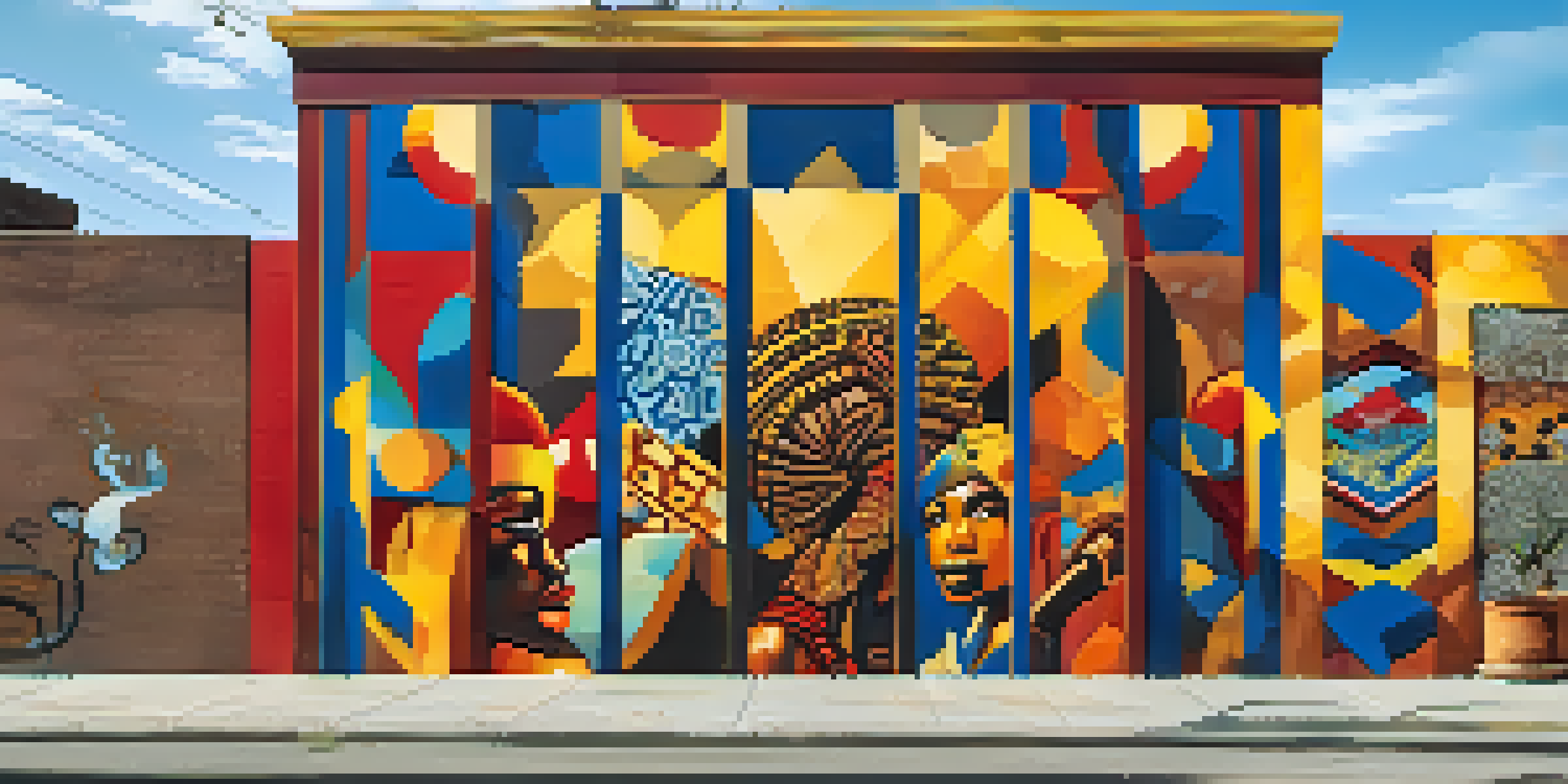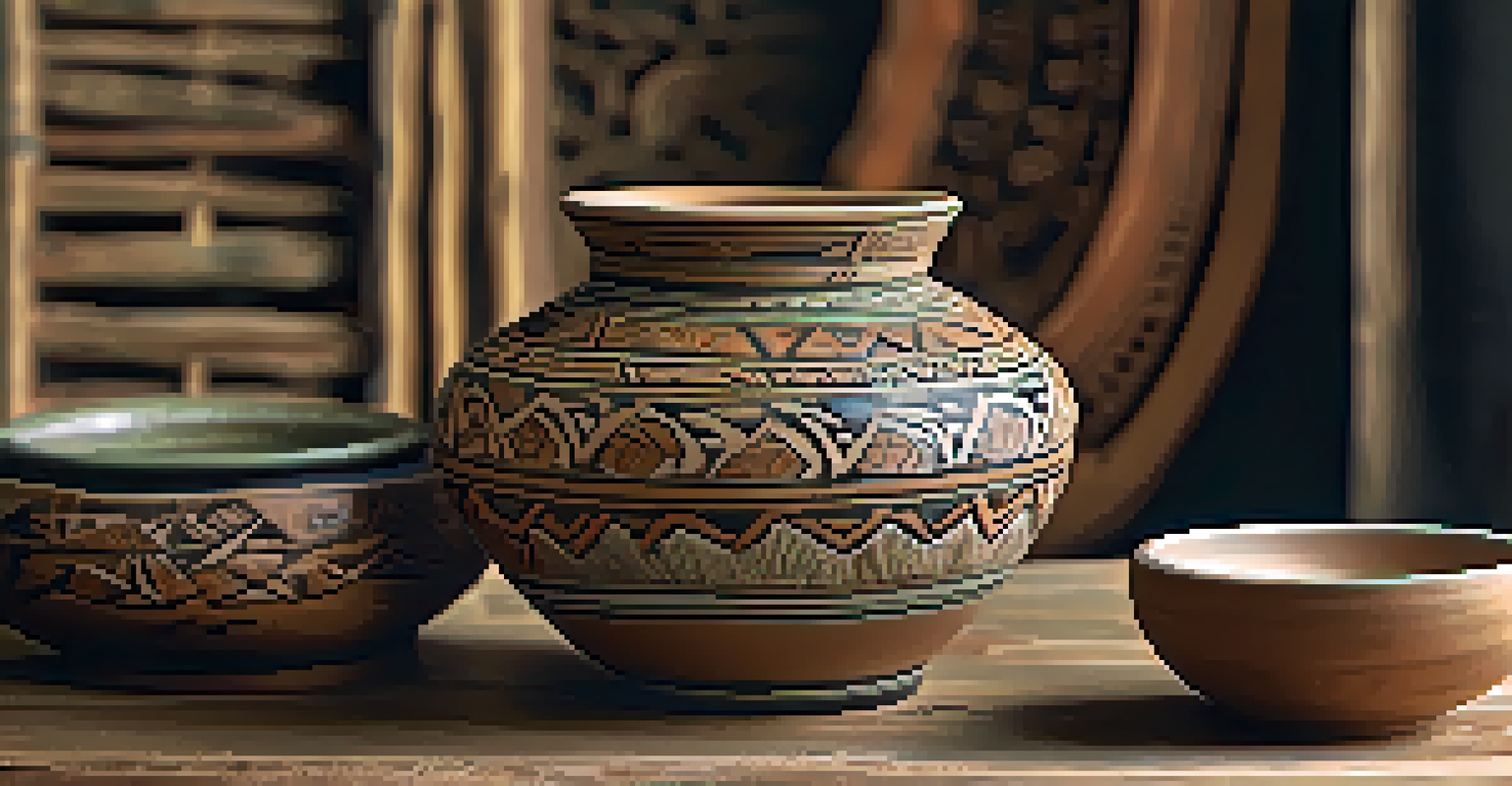Cultural Heritage and the Evolution of Modern Art Forms

Understanding Cultural Heritage and Its Significance
Cultural heritage encompasses the traditions, languages, and artifacts passed down through generations. It's the DNA of a community, shaping identities and values. Understanding this concept is crucial as it lays the groundwork for how art evolves and reflects societal changes.
Culture is the arts elevated to a set of beliefs.
In many ways, cultural heritage acts as a canvas for modern artists. They draw inspiration from the past, infusing their works with historical significance. This connection not only honors traditions but also invites contemporary audiences to engage with the narratives that shape our world.
For instance, artists like Kehinde Wiley blend classical portraiture with contemporary themes, showcasing how heritage can be reinterpreted. By examining cultural roots, modern art becomes a dialogue between the past and present, allowing for both innovation and reflection.
The Impact of Globalization on Artistic Expression
Globalization has drastically changed the landscape of art, creating a melting pot of styles and influences. Artists today can easily access diverse cultural elements, leading to the fusion of traditional practices with contemporary techniques. This cross-pollination enriches modern art, making it increasingly dynamic and multifaceted.

Take, for example, the rise of street art, which often incorporates global themes and cultural references. Artists like Banksy utilize their platforms to comment on social issues, drawing from a wealth of cultural heritage while connecting with a worldwide audience. This evolution showcases the power of art as a tool for communication across borders.
Cultural Heritage Shapes Art Today
Cultural heritage serves as a foundational element for modern artists, influencing their work and connecting contemporary audiences to historical narratives.
However, this blending of cultures can also raise questions about authenticity and appropriation. As artists navigate these complexities, it's essential to strike a balance that honors original cultures while embracing innovation in artistic expression.
Revival of Traditional Techniques in Modern Art
Interestingly, many contemporary artists are reviving traditional techniques, breathing new life into age-old practices. By employing methods like hand-weaving, pottery, and painting, they not only preserve cultural heritage but also create a bridge to modern art forms. This revival often results in stunning pieces that resonate deeply with viewers.
Art is the most beautiful of all lies.
For instance, artists such as El Anatsui use discarded materials to create intricate sculptures that echo traditional African textiles. This approach not only honors heritage but also addresses issues of sustainability and consumerism, making a powerful statement through art.
This trend highlights how blending old techniques with modern themes can yield works that are both relevant and poignant. It's a reminder that the past can inform the present, allowing artists to craft narratives that reflect contemporary realities.
Cultural Appropriation vs. Appreciation in Art
As artists draw inspiration from diverse cultural backgrounds, the line between appreciation and appropriation can blur. Cultural appropriation occurs when elements of a culture are used without understanding or respect, often leading to backlash. On the other hand, appreciation acknowledges and honors the source, fostering a collaborative spirit.
Artists must tread carefully, being mindful of the cultural significance behind the elements they incorporate into their work. Engaging with communities, conducting thorough research, and respecting traditions are vital steps in ensuring that art remains a celebration rather than an exploitation of culture.
Globalization Fuels Artistic Fusion
The impact of globalization has transformed artistic expression by blending diverse cultural styles and themes, enriching the art landscape.
For example, many indigenous artists advocate for the importance of sharing their stories authentically. By collaborating with these artists and amplifying their voices, modern art can create a space for genuine dialogue and understanding, enriching the artistic landscape.
The Role of Technology in Modern Art Forms
Technology has revolutionized how art is created, shared, and experienced. From digital painting to virtual reality installations, artists are harnessing new tools to push the boundaries of creativity. This evolution not only changes the medium but also expands the audience, making art more accessible than ever.
For example, social media platforms allow artists to showcase their work globally, breaking down geographical barriers. Artists like Krista Kim use digital platforms to create immersive experiences that resonate with a broad audience, demonstrating how technology can enhance artistic expression.
However, this reliance on technology also raises questions about authenticity and the future of traditional art forms. As we navigate this digital landscape, it’s crucial to find harmony between innovation and the preservation of cultural heritage.
Art as a Reflection of Societal Changes
Art has always mirrored the societies in which it exists, evolving alongside cultural shifts and movements. From social justice to environmental concerns, modern art often serves as a response to pressing issues, prompting reflection and dialogue. This responsiveness keeps art relevant and powerful, reinforcing its role as a catalyst for change.
For instance, the rise of activism in art highlights how artists use their platforms to address societal concerns. Works that tackle themes like climate change or racial inequality resonate deeply with audiences, inviting them to engage with these critical issues.
Navigating Appropriation in Art
As artists draw from various cultures, it’s essential to distinguish between appreciation and appropriation to foster genuine respect and collaboration.
As artists navigate these societal changes, their works often become beacons of hope and resilience. This dynamic relationship between art and society underscores the importance of cultural heritage in shaping narratives that reflect contemporary realities.
The Future of Cultural Heritage in Modern Art
Looking ahead, the integration of cultural heritage in modern art will likely continue to evolve. As artists increasingly engage with their roots, we can expect to see more innovative expressions that honor tradition while pushing boundaries. This journey will undoubtedly foster a richer artistic landscape, inviting new voices and perspectives.
Additionally, as global conversations around diversity and representation grow, the importance of cultural heritage in art will become even more pronounced. Artists will continue to challenge norms, drawing upon their unique backgrounds to create works that resonate universally.

Ultimately, the future of art lies in its ability to adapt and respond to the ever-changing world, all while cherishing the rich tapestry of cultural heritage. This balance will ensure that modern art remains a vibrant reflection of our collective human experience.